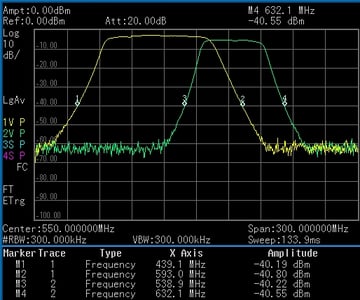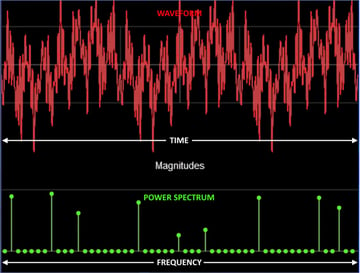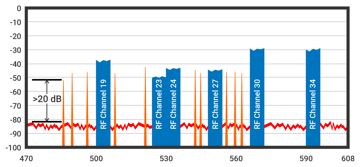Why does reducing the out-of-band noise of a receiver improve the signal quality at carrier frequency?

An important characteristic of any radio receiver is selectivity — that is, its ability to detect and demodulate only the desired signal and not other nearby signals. The best way to ensure this is to maintain a good signal-to-noise ratio; a signal that is at least 20 dB above the surrounding RF noise floor will help the receiver achieve what’s called “capture effect,” where the receiver can hold onto the frequency-modulated signal.
We users of wireless audio usually share our spectrum with other UHF users, most notably terrestrial broadcast TV stations. Adjacent to our UHF band (470 to 608 MHz in North America) are other services and RF sources, including RF noise from video walls and other such electronics, as well as RF carrier signals from 5G mobile phones.
Some noise from LEDs and video walls and other increasingly present electronics creeps right into the lower end of our UHF band. The mobile phone noise, however, starts at frequencies outside the upper end of the band.
Why are we concerned with out-of-band noise? Our receivers won’t pick it up. That’s right, they won’t, but we could still get interference through intermodulation, or IM. IM occurs when multiple signals are present in nonlinear circuitry, such as an antenna amplifier, distro, or receiver front end that is even slightly overdriven by high signal levels. When we coordinate frequencies for wireless audio, i.e., wireless mics and IEMs — which you should do for any system of more than two frequencies — your data entries and calculated results include all of the known signals in the system. The frequency coordination program calculates compatible frequencies that will not produce intermodulation distortion (IMD) artifacts that fall on or near the frequencies we’re using. The other noises, though, we don’t know so well. It’s practically impossible to calculate IM issues for signals that are indeterminate, like video display EMI or mobile phone signals.

The best thing we can do is just filter those signals out in the first place, before they can reach any active circuitry. RF Venue offer six different bandpass filter models, each covering a different frequency range: 470 to 530 MHz, 470 to 560 MHz, 530 to 590 MHz, 560 to 608 MHz, 470 to 608 MHz, and 470 to 698 MHz. Use them in pairs ahead of the antenna distro or any other active circuitry in the cabling from the antennas. The whole-band filters (470 to 608 MHz, or 470 to 698 MHz for the EU and other global locations) are useful in systems where the wireless mic frequencies may vary or are not yet determined (such as a rental system), but if you can use a narrower passband that fits your wireless mic channel frequencies, they will filter out even more noise, TV stations, and other possible sources of intermodulation.
Bob Lee
Bob Lee is an application engineer and trainer at RF Venue, Inc., having worked in pro audio and broadcasting for more than four decades. Bob started doing live theatre sound in 1980 with analog boards and area mics, because only the biggest theatre companies had wireless back then. He designed and serviced wireless...
More from the blog
Subscribe to email updates
Stay up-to-date on what's happening at this blog and get additional content about the benefits of subscribing.



